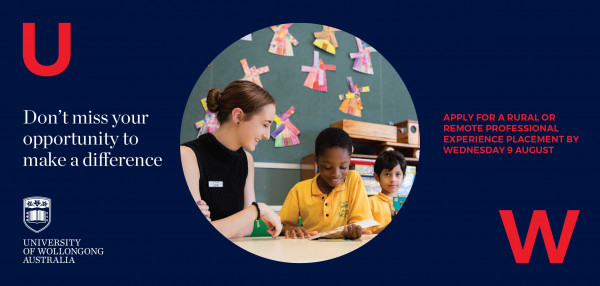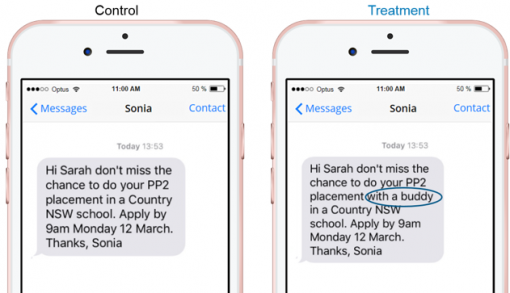Applying behavioural insights to get trainee teachers to rural and remote NSW
We partnered with the NSW Department of Education to apply BI to attract trainee teachers to apply for professional experience placements in rural and remote NSW.

Worldwide, private and public sector employers struggle to attract and retain professional staff in rural and remote (R&R) areas – be they nurses, teachers, or even bank tellers. At the BIU, we recently presented our progress in this area at the NSW Council of Deans conference in Newcastle, to the Tax and Transfer Policy Institute’s Conference on Behavioural Economics and Public Policy in Canberra, and to the Institute of Public Administration NSW’s Behavioural Insights Forum in Sydney.
While financial incentives like salary bonuses or tuition funding are typically used to attract more people to work in R&R areas, money is just one possible motivator. Recognising this, the NSW Department of Education approached us in 2016 to complement their financial incentives with a behavioural approach. Our goal was to get more metropolitan trainee teachers to apply for professional experience placements in R&R NSW.
Behavioural science suggests that anyone offering choices is a ‘choice architect’ and can influence decisions by the way choices are offered. We applied choice architecture to the placement decision by making the process easy, attractive, and social, with timely reminders.
To understand how best to do this, we spoke with staff at the NSW Department of Education, Deans and professional experience placement officers at metropolitan universities, and we surveyed 230 trainee teachers online. We learned that trainee teachers want to enhance their career prospects, meet the challenge of broadening their work experience, or “make a difference”. They also like the idea of being able to support one another on placement: they shared stories with us of previous placements where they had been placed in the same school at the same time with other trainee teachers. Our research also identified behavioural barriers and triggers that needed to be addressed.
Identifying behavioural barriers or triggers
We learnt that gaining professional experience is extremely stressful for trainee teachers. The placement decision is filled with unknowns e.g. the school itself, the mentor teacher, the lesson plan. The placement decision typically also requires research about the school and its surrounds.
Furthermore, trainee teachers were inclined to stick with the tried and tested, preferring to keep their commuting and family arrangements as unchanged as possible. (Known as the status quo bias, this barrier is aggravated when the required behaviour has high effort requirements or friction costs.) At some universities, the friction costs for a R&R placement were far higher than for a metropolitan placement: trainee teachers had to email university staff if they wanted a R&R placement, whereas metropolitan placements were offered as part of the placement process.
Given the research effort involved, the friction costs and the uncertainty, trainee teachers were likely to use the familiarity heuristic or rule-of-thumb: they chose schools they knew more about over schools they knew less about. Indeed, we saw students open up a list of possible professional experience schools on their computer screen; skim through the list, and pick out familiar suburbs or school names.
Across the three universities, we also noticed that their newly implemented placement software was directly influencing trainee teachers’ decisions. For example:
- The software showed schools in order of proximity to each trainee teacher’s home address. This order effect favoured the closest schools: most students didn’t bother to work through the entire list. In some instances, R&R schools weren’t even shown.
- The software showed trainee teachers a list of dozens of schools. Faced with too many options, or choice overload, trainee teachers favoured familiar local schools over unknown schools.
- The software automatically matched secondary school trainee teachers, defaulting them to a placement at the school nearest to their home.
Trainee teachers were inclined to rely heavily on the advice of influential messengers like family, peers and friends in their social network to avoid effortful research.
We tried three interventions
Together with our university partners, we co-designed three interventions. To overcome the status quo bias and use of the familiarity heuristic, we worked closely with the professional experience offices to simplify the application and research process to encourage R&R placements.
Using randomised controlled trials (RCTs), we tried three interventions in practice:
Intervention 1: Timely and personalised communications
In mid-2017, together with the University of Wollongong, we made the R&R placement opportunity more noticeable and attractive using the appeals that students had shared with us. We compared the percentage of applications received from an under-graduate group receiving a personalised postcard, email, and reminder text message, with those of a control group.
The intervention had a significant effect, getting three times more applicants for R&R placements (12.6% versus 4.2% of all applications).

Intervention 2: Simplifying the research process and using an influential messenger
"I spent 4 weeks in Broken Hill at the end of 2016 doing a placement there on a Year 2 class and ... by far and away the best part of my degree." - Ellie Burgess
In August 2017, working with Macquarie University, we added specific information about the R&R school on offer (e.g. hyperlinks to the school’s web page and the tourism page for the school’s region) and the chance to go with a group. Our email used an influential messenger: a hyper-linked testimonial video from a trainee teacher who had previously undertaken a R&R placement.
Our results were promising, with a 9.8% R&R application rate in the treatment group, as opposed to none in the control group.
Intervention 3: Peer-placements
In March 2018, Western Sydney University helped us to test peer-placements. Here we trialled offering the chance to go with a peer to a post-graduate trainee teacher group, using personalised emails and reminder texts. The peer-placement idea was popular and is worth exploring further despite not getting significantly more R&R applications (1.7 times more applications).

Why these trials were important
Everyone knows that it’s not all about the money. We showed that other factors influence trainee teachers choosing placements in R&R schools. Our trials were remarkably impactful: some of these trainee teachers have already accepted positions at the NSW R&R schools where they did their placement and others have changed their perspective: “I will never hesitate to apply for a job in a rural/remote area after experiencing first-hand how incredible it can be" UOW – 2nd year trainee teacher.
All three trial partner universities have adopted the interventions as business as usual. The NSW Department of Education will now drive implementation at identified major metropolitan universities.
If you would like to read more about this project ,see our 2018 annual report (PDF 2.35MB).
Published: 11 September 2018